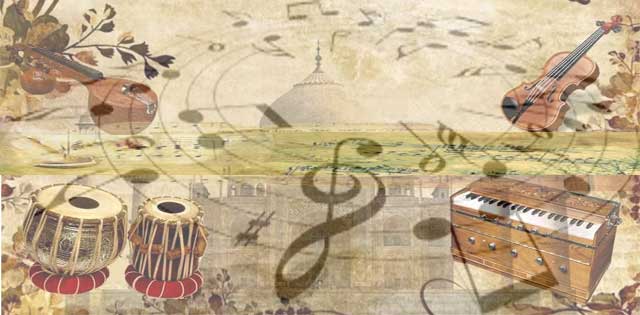- Visitor:19
- Published on:
Misappropriation of North Indian Art Music
Due to predominantly Muslim names in the world of North Indian Art Music (NIAM), we have been convinced that the music has Arabic or Islamic roots. However, the Moghuls could convert the artistes, but failed to change what they sang and played as it required very high levels of understanding and cultural knowledge to do so.

Abstract
Due to predominantly Muslim names in the world of North Indian Art Music (NIAM), we have been convinced that the music has Arabic or Islamic roots. However, the Moghuls could convert the artistes, but failed to change what they sang and played as it required very high levels of understanding and cultural knowledge to do so. For instance, I have charged elsewhere that they merely changed an attractive vocal art sub-form of Dhrupad and termed it in Arabic as ‘Khayāl’. However, by merely changing the name of an art, it cannot be misappropriated for long. Its contents and labels betray this misappropriation. I present concrete reasons why NIAM is fully native. NIAM is not influenced or started by groups of invaders . This is similar to saying that an imaginary tribe from Steppes allegedly attacked and destroyed the Indus civilisation, but at the same time gave the highly sophisticated Veda-s to this part of the world.
Introduction
That north Indian art music (NIAM) often referred to as Hindustani Classical Music, had been hugely influenced by Islāmic invaders is a common assumption. Credibility to this was lent by citing the musicians’ names which were predominantly Muslim. Although leading non-Muslim musicians were merely converted, the converts pursued the same art in the same form that they had painstakingly taught and learnt in a long earlier tradition. None can really pin point the exact contributions of Arabs/Turks to NIAM.
An art of the highest order such as NIAM could not possibly be the gift of the Moghuls. Gier (May 2006, p.1) gives enough evidence to show the genocide, destruction, and conversions during their attacks and reign.
Arguments
In NIAM, there are few Arabic/Turkic words, terms, and concepts. All NIAM terms and concepts are Gīrvāṇ [1]. I shall take up some key definitive terms for analysis as evidence to show its cent per cent native content. Here’s a short list (translations may not give exact meaning given from my traditional knowledge):
Svar – tone
Śruti – microtone
Komal/Ati Komal – flat/very flat
Tīvra/Tīvratar/Tįvratam/Śudhdha – Sharp/Very Sharp/Most Sharp/Pure
Tāl – Cyclic Temporal format
Lay – Pace
Āvartan – Cyclic Temporal Arrangement
Sam – the start and end point of āvartan.
Mātrā – the minimum unit of tāl.
Khand – A temporal section in tāl with specific number of mātra-s which might or might not be uniform all through the tāl.
Ćhand – A kind of gait. Different from Vedic Ćhand.
Bandiś – Ideally inviolable composition
Rāg & Rāg Names – Gamut and Gamut Names
Tāli & Khāli – mātrā indicators shown by hand by singer/musician
Rāg Rules: Vādi, samvādi, vivādi, graha, anśa, nyās, apanyās, āroha, avaroha, alpatva, bahutva.
Vāṇi/Bāni – sound , voice , music (a choir of musicians or singers). The spata Vāṇi-s are seve metres or to the seven notes of the gamut. [2]
I shall take some of the above terms for discussion. Obviously they’re not Arabic/Turkic and hence to claim ‘influence’ is at least zealous and unscholarly. Now, ‘svar’ can be broken up as Sva+ Rajari literally meaning self-luminous (Mātang around 8th C). The concept and etymology are of Indic origin. [3] Svar, according to my own insight, is therefore an entity that illuminates (throws light upon) akin to the Indic phenomenon of self-perpetuation.
‘Śruti’ is contextual and has several meanings. In the musical context, I think it means any svara that can be heard. ‘Śrut’ is its root referring to the faculty of hearing. Komal refers clearly to flat svara-s or semi-tones.‘Ati Komal’ refers to microtones – the hallmark of Dhrupad singing in NIAM and in South India. Tīvra svara-s are sharper microtomes than the Komal svara-s, but are placed below the Śudhdha svara. Tīvratar to Tīvratam are microtones below the Śudhdha which is the sharpest svara variety as per older traditions in Dhrupad. [4]
Note that due to these svara characteristic each rāga is different from the other. Even if the apparent constituents are the same (e.g., Bhūp & Deśkār both are pentatonic and eschew the fourth and sixth svara-s). Rāga music if communicated in written form in the manner done in Western musical traditions, is problematic. Rāga does not employ mere frequencies and fixed tonal positions. For instance the Kākali Niśād is not a single note with a fixed frequency. Moreover, one needs to learn such finer things in the oral-aural method. While most Western classical music is written, NIAM is passed down primarily through the oral-aural tradition like the Veda-s. This was a cultural given which the written form of NIAM taught in new ‘vidyālaya-s’ have unwittingly undermined. The complex teaching-learning method based of the ancient Śikṣā (phonetic, phonological) philosophy has been largely supplanted by Western notations. This degeneration has been compounded by the use of the tempered scale rather than the ancient Indian natural scale. Further degeneration is evidenced in the replacement of the Tānpura by the electronic drones (however, justified they might be logistically).
Rāga and rāga names: Rajayate iti ragah [5] is a well known Gīrvāṇ (and often cited) definition of Rāga although it is not comprehensive of the idea of rāga. [6] Also the phenomenon of rāga comes from an earlier concept of murchana-prastār which finds definition in Bharata’s Nātya Šāstra (around 300 BC). [7] I do not know if Arab/Turky has any such indigenous high context for its Maquām-s.
Significantly, an overwhelming majority of rāga names are in Gīrvāṇ and not in Arabic. Barring the few exceptions like Zeelaf (which is a very new rāga, but a variety of Bhairav which is Gīrvāṇ), Śāhānā (A variety of Kānhadā which comes from Kānhā – the name of Śri Kriṣna) all other rāga-s and rāgini-s have Gīrvāṇ names.
More significant is the choice of names. A sizeable number are names of Indian places and deities. Rāg names with places of India and not Arab/Turkey – Multāni (Multān), Sourāśtra (Sorath), Veravāli (Bilāwal)[Verāval in Gujarāt], Gaud (Sārang, Malhār, etc) [8] [usually refers to the area of Bengal these days], Mālavi Kausi Koya (Māl Kauns) [Malva of Madhya Pradeś]. Rāg names with deities of India – Durgā, Sarasvati, Śankarā, Śree, Bhairav, Bhairavi, Yogiya (Jogiya), etc. Importantly, seasons or signs that are not found in Arab are names of rāga-s – Vasant/Basant, Megh, Malhār. Although Turkey too witnesses these seasons, song forms like Dhamār/Hori are of very high context and unique to the season of Phāgun month (February-March) in India when Śrī Kriṣna plays Holi with his gopi-s. Also, lyrics of old bandiś-es are in Sanskrit or predominantly Braj Bhāṣā.
In Indian music Dhrupad is a word derived from Dhruva + Pada which roughly means the repeatable part of a song and which does not change during the singing session. It is also an umbrella term for Dhrupad, Dhamār, and Sadrā forms of singing. Yāskāćārya (Vedic etymologist of the around 6th C BC) defines the word Dhruva as something which brings the mind to a state of rest. Rāga treatment in Dhrupad does exactly this.
The word Bandiś, I reckon comes from the Gīrvāṇ word bāndh. Now bāndh is a Sāma Vedic concept which functions as a dividing pause between two parts of a Sāman mantra. These parts are known as parvan-s or more accurately parvāṇi. Śikṣā is the repetition of a parvan until pronounced with the right accentuation and intonation, leading to a comprehensive cultural communication minimising transmission losses. When repetition by students happens, a cyclic temporality is created for long durations of time leading to a parvan becoming a Bandiś. So a Sām mantra as I see it, comprises several Bandiś-es. Each such Bandiś has a different temporality and gait. These lead to the concepts of āvartan, tāl, and sam. In effect, a parvan has a tāl (root of which is tal meaning plinth or base). Sam is the beginning and end point of the parvan and hence that of the ‘Bandiś’. The concept of āvartan is explained in depth by the Roy (2011-12, pp. 72-85). [9]
Conclusions
All definitions point to older Gīrvāṇ and Vedic roots of NIAM. Since the Vedic period is older than Arabic/Turkic civilisation, we reasonably say that NIAM originated in India. The Arabic/Turkic influence has been minimal considering the above evidences. The Moghul and Colonial eras have caused a degeneration of the older musical culture of India.
Since all the above terms cannot be represented in any other word than Dhrupad, it points towards a clear misnaming of an older Dhrupad form to ‘Khayāl’ which merely is an Arabic name of a completely Indian musical form and is very likely misappropriation.
The above discussion does not cover Maquām-s that the Arabic world practices and is believed to be akin to rāga-s. Also, it does not afford a survey of Arabic terms which might be cognates of the above concepts. In any case, the antiquity of the above terms and concepts rule out the possibility of an import from Arab/Turkey.
References
- Girvāṇ is what we call today as Gīrvāṇ. It is the actual name of the language. It is different from Ved Vāṇi which essentially is a communication between Riṣi-s and Devi/Devatā-s in altered states of consciousness. Roy, S. (Aug 11, 2013). Gīrvāṇ permeated music in languages. Accessed from https://www.speakingtree.in/blog/music-in-language on March 10 2021.
- Accessed form https://sanskrit.inria.fr/MW/232.html#vaa.na
- P.L. Śarmā’s edition of Brihaddeśi of Śri Mātang Muni. (1992). New Delhi:Indira Gandhi National Centre for the Arts. pp. 87-89.
- It needs to be ascertained whether these svara characteristics remain the same in different rāga-s. This question is important because in tradition we’re told that each rāga has a subtly different key
- Harper, D. Rajyati means to dye. Accessed from https://www.etymonline.com/word/raga
- ‘one of the ancient traditional melodic patterns or modes in Indian music.’ Merriam-Webster. (n.d). Accessed from https://www.merriam-webster.com/dictionary/raga.
- Mukhopādhyay H.N. (1926). Dhrupad-Svarlipi. Prayag: Indian Press. P-9.
- In ancient & mediaval India, Gaud was a group of people called the Gaudiya or Panć Gaudiya Brahmana-s. Also, the Gaurhar Bānid of Dhrupad is believed to be the root of ‘Gaud’.
- Roy, S. Cyclic Time in Indian Art Music & Creativity. Journal of Indian Musicological Society, 41, 72-85. 2011-12.[Part of PhD thesis titled Examining Āvartan in Khayal.]
Center for Indic Studies is now on Telegram. For regular updates on Indic Varta, Indic Talks and Indic Courses at CIS, please subscribe to our telegram channel !
- 9 min read
- 0
- 0







.jpg)

.jpg)
